Overview
The speed and depth of the impacts from the COVID-19 pandemic, and the ongoing government responses to them, are unprecedented. The Queensland Government has announced a range of measures with the aim of supporting the state economy, promoting public safety, and assisting households and businesses. As at 21 August 2020, the Queensland Government had announced over $7 billion in response measures. The costs of the government’s response are significant and will largely depend on the ongoing health and economic impacts of the pandemic.
Tabled 22 September 2020.

Auditor-General’s foreword
This report is the first phase of our audit program examining the Queensland Government’s response to the COVID-19 pandemic. It aims to promote understanding of the various government response measures and their costs.
This first report does not assess the effectiveness or value for money of the government’s response measures. Its aim is to inform our future audit program and identify other areas of focus for additional assurance reports. We plan to publish a three-year annual work plan in early 2021, which will outline the assurance reports we plan to conduct.
We have not audited the information included in this report for completeness or quality—we provided central government agencies with the opportunity to review and confirm the accuracy of the information relating to them.
It is critical that government-led responses are supported by sound controls to manage any additional risks, and effective governance and leadership must continue. It is important that entities apply the insights from our audits across government to new and emerging programs being delivered in response to COVID-19. In my reports, there are learnings that are useful to all entities as we respond to COVID-19 impacts.
For example, in report number 14 for 2017–18, The National Disability Insurance Scheme, I emphasised the importance of strengthening program oversight and governance arrangements across government. In my report, I also highlighted the challenges and risks of not having a whole-of-government approach to program management and reporting arrangements.
While collating this report, we were unable to obtain information on some aspects of the response measures. Both Queensland Treasury and the Department of the Premier and Cabinet told us that, although they are involved in coordinating the response, they do not have complete information about what the uptake rates of the individual measures are.
We recognise that government agencies have had to work under extraordinary circumstances during the pandemic, rapidly designing response measures to unprecedented events. However, it is critical that the effectiveness of the government’s response is monitored and assessed to determine whether program outcomes have been achieved. This requires fit‑for‑purpose governance and reporting arrangements at a whole-of-government level.
Brendan Worrall
Auditor-General

Summary
The COVID-19 pandemic (COVID-19) is causing significant adverse impacts on individuals, businesses and the Queensland economy. The speed and depth of the impacts, and the ongoing government responses to them, are unprecedented.
The Queensland Government has announced a range of measures with the aim of supporting the state economy, promoting public safety, and assisting households and businesses. The costs of the government’s response are significant and will largely depend on the ongoing health and economic impacts of the pandemic.
This report covers the government’s response measures up to 21 August 2020. It covers key measures across four response areas—health care, support for individuals, support for businesses, and public safety. The report does not cover all of the government’s initiatives, such as its response through the COVID Safe Business Framework.
As at 21 August 2020, the Queensland Government had announced over $7 billion in response measures, representing two per cent of gross state product. (Gross state product is an aggregate measure of the total economic production of goods and services, including international and interstate trade). This is in addition to $314 billion of response measures announced by the Australian Government (National Cabinet Media Statement, 7 August 2020). We acknowledge that while our report covers the period 25 January 2020 to 21 August 2020, the Queensland Government announced further response measures on 7 September 2020 as part of its COVID-19 Fiscal and Economic Review. As a result, the measures now total more than $8 billion.
Given the substantial additional expenditure required to meet the government’s COVID-19 related commitments, the Queensland Government sought legislative approval for this funding. In April 2020, the Queensland Parliament passed the Appropriation (COVID-19) Act 2020, providing funding of $4.8 billion over two years—$3.18 billion in 2019–20 and $1.62 billion for 2020–21.
The balance of the government’s expenditure is expected to be funded through existing appropriations, but not all of the response measures involve actual payments from the government to the intended recipients. The Queensland Government’s response measures also include support in the form of tax relief and rent waivers.
Central agencies should consider the following questions as part of their governance role for the Queensland Government’s COVID-19 response:
- What are the objectives of each response measure and how will their effectiveness be measured?
- What are the uptake rates of the response measures and how does this compare with what was expected when the initiatives were announced?
- What are the actual costs of delivering the response measures?
Snapshot
This snapshot highlights the key facts relating to the Queensland Government’s response to COVID-19.
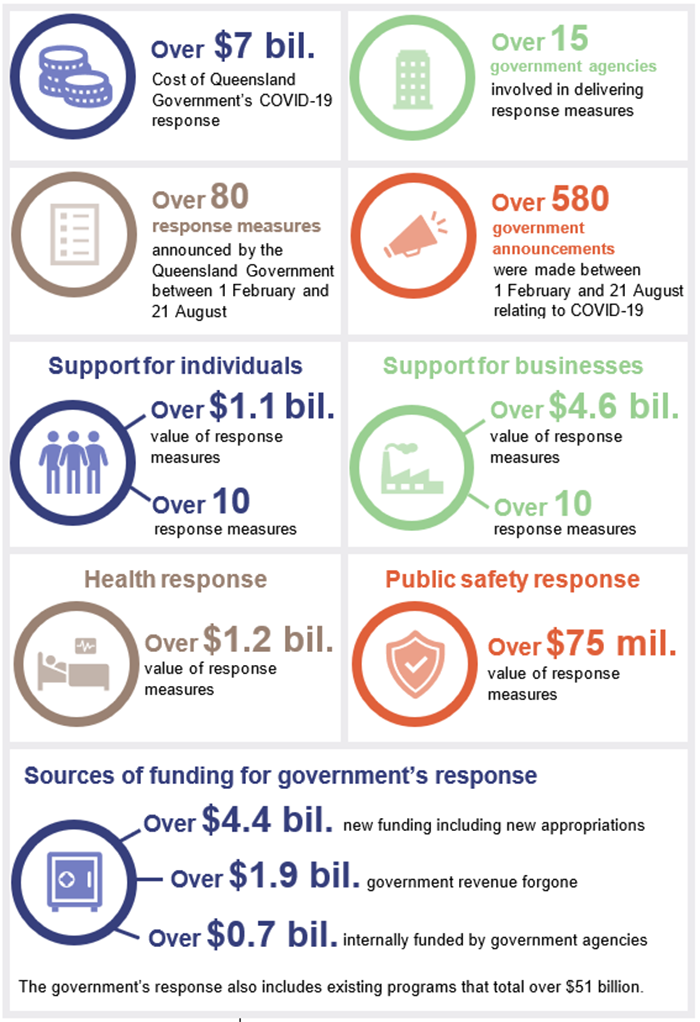

1. COVID-19 key events
On 29 January 2020, under the Public Health Act 2005, the Minister for Health and Minister for Ambulance Services made an order declaring a public health emergency in relation to the COVID-19 pandemic (COVID-19).
From mid-February 2020, the Queensland Government began announcing a range of economic stimulus support measures in response to COVID-19. On 19 May 2020, the government announced Queensland’s Economic Recovery Strategy—Unite and Recover for Queensland Jobs (economic recovery strategy) to assist the state to recover from COVID-19.
Stage one of the economic recovery strategy built on the government’s initial response to the crisis, while stage two focuses on supporting traditional industries such as construction, agriculture, and resources. Further stages of the economic recovery strategy include providing Queenslanders with the skills they need to find meaningful jobs and set up pathways for the future. Figure 1A shows the key stages of the government’s response to COVID-19.
On 20 August 2020, the Queensland Government released Queensland’s Economic Recovery Plan (economic recovery plan). The aim of this plan is to drive the state's longer‑term economic response.
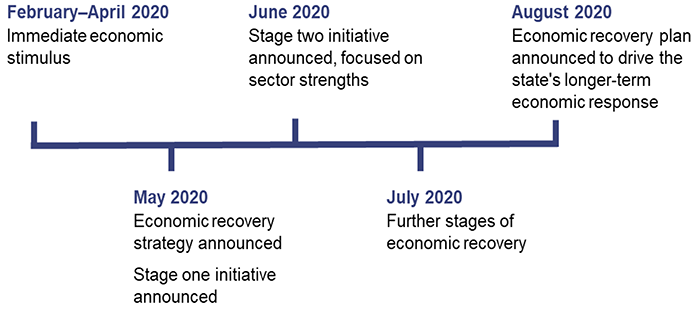
Queensland Audit Office based on information from Queensland’s Economic Recovery Strategy—Unite and Recover for Queensland Jobs and Queensland’s Economic Recovery Plan.
Since the start of COVID-19, several key events, including various government announcements, have affected individuals, businesses and the broader Queensland economy. Figure 1B shows a timeline of the key events in the Queensland Government’s response to COVID-19. A more detailed timeline of events is set out in Appendix C.
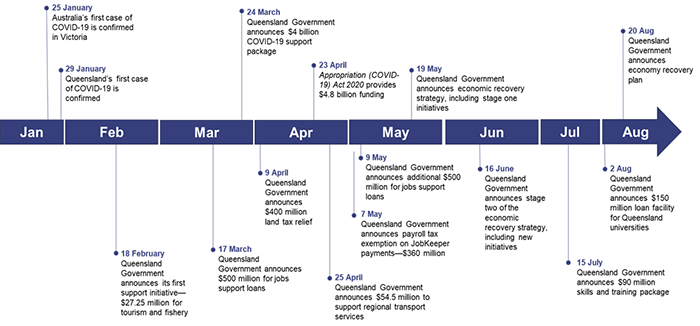
Note: The timeline does not include all government announcements on COVID-19.
Queensland Audit Office analysis of government media statements, government websites, Queensland’s Economic Recovery Strategy—Unite and Recover for Queensland Jobs and Queensland’s Economic Recovery Plan.

2. Government’s response measures to COVID-19
This chapter provides more information about the Queensland Government’s response to the COVID-19 pandemic (COVID-19) across the four key response areas—health care, support for individuals, support for businesses, and public safety. Figure 2A shows the cost of the government’s COVID-19 response.
Queensland Audit Office analysis of government media statements, government websites and information provided by Queensland Treasury.
How is the Queensland Government supporting the health response to COVID-19?
The Queensland Government is providing $1.2 billion funding to increase the capacity of Queensland’s health system to confront COVID-19. This includes expanding the capacity of fever clinics, emergency departments, acute care services, and regional aeromedical services for our remote communities. Of the $1.2 billion, Queensland Treasury has transferred $0.48 billion (40 per cent) to Queensland Health, as of 30 June 2020.
Figure 2B shows the health system areas the government is targeting through this response measure.
|
Expanding the capacity of Queensland’s health system |
|
|---|---|
|
|
Queensland Audit Office analysis of government media statements and government websites.
The Queensland Government's other key measures supporting the health response to COVID‑19 include:
- $10 million funding to The University of Queensland to support the development of a COVID-19 vaccine
- $28 million in grants to community-based health service groups to ensure vital services can continue
- $21 million to combat the spread of COVID-19 amongst First Nations Queenslanders
- $46.5 million for local mental health community treatment and support services.
Estimated total cost of Queensland’s health response to COVID-19
In March 2020, the Queensland Government estimated the total cost for the COVID-19 health response to be $2.34 billion. This was based on an initial forecast that there would be a major peak in COVID-19 cases towards the end of April 2020. Of the total estimated cost, the Queensland Government allocated $1.2 billion in accordance with the new National Partnership on COVID-19 Response, signed by all Council of Australian Governments (COAG) leaders on 13 March 2020, where a 50-50 share of funding between the Commonwealth and the states and territories was agreed. Figure 2C shows Queensland Health’s anticipated expenditure, estimated as at March 2020.
Note: *Estimated costs for the period from 21 January to 31 October 2020—estimated to be $2.34 billion as at March 2020.
Inquiry into the Queensland Government’s health response to COVID-19.
How is the government supporting individuals?
The Queensland Government has introduced support measures for people facing specific economic or personal difficulties as a result of COVID-19. These measures are in addition to the Australian Government’s economic response and are expected to cost over $1.1 billion. Figure 2D provides an overview of the Queensland Government’s measures to support individuals.
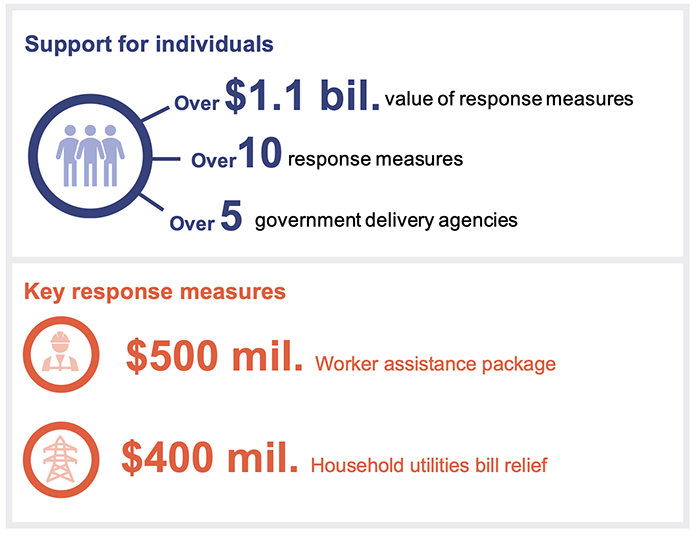
Note: All information on costs is from government figures unless stated otherwise.
Queensland Audit Office analysis of government media statements, government websites and information provided by Queensland Treasury.
Figure 2E sets out key activities that the Queensland Government is undertaking to support individuals and the associated costs, where we have been able to identify them.
| Type of support | Description | Lead agency | Estimated costs ($m) | Funding source |
|---|---|---|---|---|
| Support for workers | ||||
| Grant for art workers | Grant program for Queensland’s independent creative artists, producers, designers, technicians and arts workers. | Department of Environment and Science (Arts Queensland) | 0.5 | Funded internally by agency |
| Support for workers with COVID-19 | A $1,500 payment is available for workers who test positive for COVID‑19 and have no access to paid sick leave. | Department of Employment, Small Business and Training | Cost estimate not available | New funding* |
| Skills and training | Initiative to create more jobs, including extending the Back to Work program. | Department of Employment, Small Business and Training | 70 | Partly funded internally by agency and with new funding |
| Support for households | ||||
| Household utilities bill relief | Household utility assistance package to all Queenslanders during the COVID-19 crisis. | Department of Communities, Disability Services and Seniors | 400 | New funding |
| Housing and homelessness support | Support for the vulnerable, particularly those who are homeless or at risk of homelessness due to COVID-19. | Department of Housing and Public Works | 24.7 | Funded internally by agency |
| Domestic and family violence support | Support services for the vulnerable, including providing accommodation during the pandemic. | Department of Child Safety, Youth and Women | 7.5 | Funded internally by agency |
| Rental grant scheme | Provides one-off payment of up to four weeks rent (maximum of $2,000) available to those affected by COVID-19. | Department of Housing and Public Works | 20 | New funding |
| Support for vulnerable communities | Support for vulnerable multicultural communities with a connections package for refugees, asylum seekers and migrants. | Department of Local Government, Racing and Multicultural Affairs | 0.9 | Funded internally by agency |
| Other support | ||||
| Support for farmers—freeze on irrigation prices | Freeze on irrigation prices in 2020–21 and the government to absorb dam safety costs, as relief for farmers. | Department of Natural Resources, Mines and Energy | 14.7 | Revenue forgone and new funding |
|
Support for farmers—drought recovery |
Drought-affected farmers to get relief from state fees and land rents. | Department of Natural Resources, Mines and Energy | 2.2 | Funded internally by agency |
| Sports funding | Government will repurpose over $50 million of sports funding to get clubs ready to operate under new COVID‑19 restrictions. | Department of Housing and Public Works | 51.3 | Funded internally by agency |
| Support for Aboriginal and Torres Strait Islander businesses | Support and telephone hotline to provide support to Aboriginal and Torres Strait Islander businesses during COVID-19. | Department of State Development, Tourism and Innovation | 0.2 | Funded internally by agency |
| Support for international students | Support services for international students, including providing professional counselling services. | Department of State Development, Tourism and Innovation | 2.2 | Funded internally by agency |
| Supporting government call centre services | Funding to build Smart Service Queensland's call centre capacity to support Queenslanders during COVID-19. | Department of State Development, Tourism and Innovation | 10 | Funded internally by agency |
Note: All information on costs is from government figures unless stated otherwise. Funding source for some measures includes revenue forgone—response measure is in the form of tax relief and rent waivers, and it does not require actual payments from government to individuals and businesses.
* Response measure forms part of the worker assistance package.
Queensland Audit Office analysis of government media statements, government websites and information provided by Queensland Treasury.
How is the government supporting businesses?
The Queensland Government has announced a number of support measures for businesses with the aim of helping them cope with the economic disruption caused by COVID-19.
These support measures are expected to cost over $4.6 billion. The full cost of some of the government’s measures will not be known for some time, as it will depend on factors such as take-up rates and how many businesses default on their loans. Figure 2F provides an overview of the government’s measures for supporting businesses.
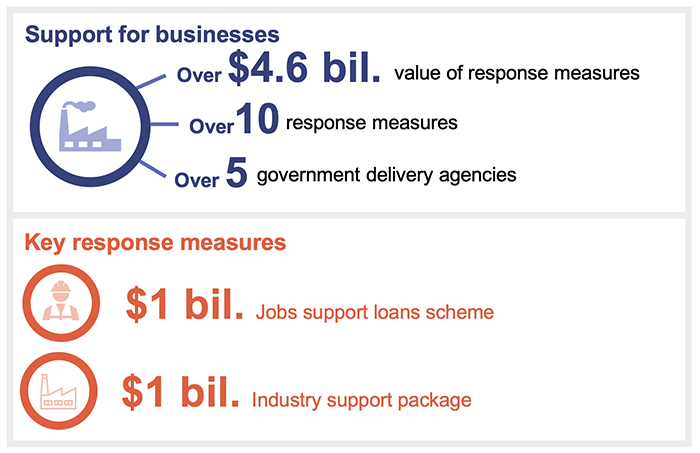
Note: All information on costs is from government figures unless stated otherwise.
Queensland Audit Office analysis of government media statements, government websites and information provided by Queensland Treasury.
Figure 2G sets out key activities that the Queensland Government is undertaking to support businesses and the associated costs where we have been able to identify them.
| Type of support | Description | Lead agency | Estimated costs ($m) | Funding source |
|---|---|---|---|---|
| Loans to businesses | ||||
| Jobs support loans | Concessional jobs support loan facility, interest free for the first 12 months, to support businesses to keep Queenslanders in work. | Department of Agriculture and Fisheries (Queensland Rural and Industry Development Authority) | 1,000 | New funding |
| Tax relief and other waivers | ||||
| Payroll tax relief | Payroll tax relief including refunds, payment holidays, and deferrals for eligible businesses. | Queensland Treasury | 950 | Revenue forgone |
| Payroll tax exemption: JobKeeper payments | Payroll tax exemption on the Australian Government’s JobKeeper payments. | Queensland Treasury | 360 | Revenue forgone |
| Land tax relief and payment deferrals | Land tax relief for property owners to pass on to tenants affected by the COVID-19 outbreak. | Queensland Treasury | 400 | Revenue forgone |
| Tax relief—clubs and pubs | Tax relief delivered as a three-month deferral on gaming machine taxes. Additionally, around 50 licensees who had already paid their gaming machine taxes for March had a total of $1.4m returned to them. | Department of Justice and Attorney-General | 50 | Revenue forgone |
| Land rent waivers | Waiving of $33.8 million in land rent for April 1 to September 30, to help support businesses. | Department of Natural Resources, Mines and Energy | 33.8 | Revenue forgone |
| Rental relief | Government’s rental relief commitment to government owned corporations and statutory bodies where their tenants are impacted by COVID-19. | Queensland Treasury | 17.7 | Revenue forgone |
| Support for resources sector | Relief for resource explorers, which includes waiving of rent on exploration land due between 1 April and 1 September 2020 and freezing fees and charges until 1 July 2021. | Department of Natural Resources, Mines and Energy | 9.1 | Revenue forgone |
| Support for tourism and fisheries sector | ||||
| Initial COVID‑19 aid package—tourism and fisheries | COVID-19 aid package for supporting tourism and fishery sectors. | Department of State Development, Tourism and Innovation | 27.3 | Revenue forgone and new funding |
| Support for tourism businesses, and theme and animal parks | Support for tourism businesses, and theme and animal parks to get through COVID-19. | Department of State Development, Tourism and Innovation | 50 | New funding* |
| Support for commercial whale watching operators | Waiving of annual commercial whale watching fees for operators affected by COVID-19. | Department of Environment and Science | 0.11 | Revenue forgone |
| Education sector | ||||
| Support for community kindergartens | Provides support for community kindergartens struggling with falling enrolments due to COVID-19. | Department of Education | 17 | Funded internally by agency |
| Support for Queensland universities | Loan facility to support Queensland universities impacted by COVID-19. | Department of State Development, Tourism and Innovation | 150 | New funding |
| Other support measures | ||||
| Electricity relief for small businesses | Power bill relief package for small businesses, including sole traders, with eligible customers receiving a $500 rebate on their electricity bill. | Department of Communities, Disability Services and Seniors | 100 | Revenue forgone |
| Support for essential public transport | Support package to allow regional air, bus, and ferry services to keep running while social distancing measures remain in place. | Department of Transport and Main Roads | 54.5 | Revenue forgone and new funding |
| Support for arts sector | Support arts organisations through funding extensions, changes to funding application time frames and rent relief. Support also included grant funding to assist individual artists and arts organisations. | Department of Environment and Science (Arts Queensland) | 11 | Funded internally by agency |
| Export grants program | Support for Queensland businesses to launch their products in global markets. | Trade and Investment Queensland | 1 | Funded internally by agency |
| Assistance to small businesses | Support services to small businesses through partnering with the Chamber of Commerce and Industry Queensland (CCIQ). | Department of Employment, Small Business and Training | 0.4 | Funded internally by agency |
| Disposable mask manufacturing in Queensland | Funding to establish a mask manufacturing capability in Queensland. | Department of Regional Development and Manufacturing | 5 | Funded internally by agency |
| Support for zoos and mobile animal exhibitors | Funding to assist operators to care for their animals. | Department of Agriculture and Fisheries | 0.5 | Funded internally by agency |
| Aviation support | Support for Brisbane Airport and regional airports affected by COVID-19. | Department of State Development, Tourism and Innovation | 5 | Funded internally by agency |
| Regional home building grant | Grant of $5,000 for people building a new home in a regional location. | Queensland Treasury | 10 | New funding |
| Support for agriculture industry | Initiative to promote consumption of Queensland produce. | Department of Agriculture and Fisheries | 0.2 | Funded internally by agency |
| Concept study—Bowen Basin gas pipeline | Funding to investigate feasibility and options for a new transmission pipeline to connect the Bowen Basin’s gas reserves to the east coast of Queensland. |
Department of Natural Resources, Mines and Energy |
5 | New funding* |
| Queensland Renewable Energy Zones | Funding to create three Queensland Renewable Energy Zones located in southern, central and northern Queensland. |
Department of Natural Resources, Mines and Energy |
145 | New funding* |
Note: All information on costs is from government figures unless stated otherwise. Funding source for some measures includes revenue forgone—response measure is in the form of tax relief and rent waivers, and it does not require actual payments from government to individuals and businesses.
* Response measure either forms part of or is funded from another support package, such as worker assistance package or industry support package.
Queensland Audit Office analysis of government media statements, government websites and information provided by Queensland Treasury.
Queensland’s Economic Recovery Strategy—Unite and Recover for Queensland Jobs
Queensland’s Economic Recovery Strategy—Unite and Recover for Queensland Jobs (economic recovery strategy) includes further initiatives, which build on the government’s initial response to the crisis. The economic recovery strategy outlines the government’s guiding principles for how it plans to get Queenslanders back to work, with a focus on three key priorities:
- building vital infrastructure
- strengthening Queensland’s industries
- enabling future growth.
The economic recovery strategy includes a range of measures, investments and projects. Some of the initiatives are new support measures, while some are government commitments to maintain existing investments. For example, stage one of the economic recovery strategy includes a government commitment to maintain the current state infrastructure investment program at $51.8 billion over the next four years.
The Queensland Government released Queensland’s Economic Recovery Plan in late August 2020. The aim of this plan is to drive the state's longer-term economic response. We have not audited the process of how effectively the government has planned and developed the economic recovery strategy, economic recovery plan and the included initiatives.
Figure 2H shows the number of initiatives per sector that form part of the government’s economic recovery strategy (stages one and two).
Queensland’s Economic Recovery Strategy—Unite and Recover for Queensland Jobs.
Figure 2I lists the initiatives forming part of the Queensland Government’s economic recovery strategy.
| Type of support | Description | Lead agency | Estimated costs ($m) | Funding source |
|---|---|---|---|---|
| Agriculture | ||||
| Digital transformation in agribusiness | To develop integrated supply chains that improve traceability, biosecurity and food safety. | Department of Agriculture and Fisheries | 5.5 | New funding* |
| Reinvigorated agricultural trade relationships | To support e-commerce and virtual trade facilitation in key markets and assist coordination of demand for additional regular air freight services. | Department of Agriculture and Fisheries | 5 | New funding* |
| Agribusiness diversification assistance | To build capability and explore potential diversification opportunities in agricultural businesses, including for tourism. | Department of Agriculture and Fisheries | 2 | New funding* |
| Construction | ||||
| Infrastructure guarantee | Government commitment to maintain the current state infrastructure investment program at $51.8 billion over the next four years: 2019–20 to 2022–23. | Queensland Treasury | 51,800 | Existing program |
| Accelerated works program | Program to deliver new road, bridge and pavement sealing works across the state. | Department of Transport and Main Roads | 442 | Funded internally by agency |
| Works for Queensland COVID recovery package | Program to support local jobs and local governments with funding for building productive infrastructure. | Department of Local Government, Racing and Multicultural Affairs | 200 | New funding* |
| Household resilience program | Program to support local industry by improving the resilience of North and Central Queensland homes against natural disasters. | Department of Housing and Public Works | 11.3 | New funding |
| Queensland Apprenticeships Centre | To assist in construction of a Queensland Apprenticeships Centre in renewable hydrogen at Beenleigh. | Department of Employment, Small Business and Training | 20 | New funding* |
| Housing Construction Works for Tradies | To boost housing supply, drive economic activity and support construction across Queensland. | Department of Housing and Public Works | 100 | Funded internally by agency |
| South East Queensland community stimulus program | Funding to local governments to support minor works and projects that create local jobs in our most affected areas. | Department of Local Government, Racing and Multicultural Affairs | 50 | New funding* |
| Support for home building | To stimulate the building market for new homes valued at less than $750,000. | Queensland Treasury | 106 | Existing program |
| Seniors and accessibility assistance | To continue providing services for seniors and people with disabilities to conduct critical home maintenance. | Department of Housing and Public Works | 10 | New funding* |
| Regional training infrastructure | To upgrade existing TAFE training campuses. | Department of Employment, Small Business and Training | 1.17 | Funded internally by agency |
| Tourism | ||||
| Queensland’s tourism industry | To fast track tourism projects and assist national tourism icons. | Department of State Development, Tourism and Innovation | 50 | New funding* |
| Airline route support | To support and encourage domestic tourism spend across Queensland. | Department of State Development, Tourism and Innovation | 5 | Funded internally by agency |
| National parks works and jobs boost | To provide visitor infrastructure upgrades and enhancements to re-energise nature-based tourism. | Department of Environment and Science | 8.9 | New funding |
| Resources | ||||
| CopperString | To continue investigating the feasibility of the CopperString project to connect the North West Minerals Province with the national electricity market. | Department of Natural Resources, Mines and Energy | 14.8 | New funding |
| New economy minerals initiative | To upscale the collaborative exploration initiative and support exploration activity for new economy minerals for emerging technologies and products. | Department of Natural Resources, Mines and Energy | 10 | New funding* |
| Mining Equipment, Technology and Services (METS) Accelerator Program | To accelerate METS small to medium sized businesses by enhancing business capabilities. | Department of State Development, Tourism and Innovation | 0.7 | Existing program |
| Renewable energy training facility | Providing $17 million to support industry to build a state of the art facility in Brisbane that provides world class training for solar and renewable energy. Industry contribution is $6 million. | Department of Employment, Small Business and Training | 17 | New funding* |
| Valeria coal mine | Declare the $1.5 billion Valeria Project a coordinated project. | Department of State Development, Tourism and Innovation | N/A | N/A |
| Arts and culture | ||||
| Arts and culture: offset revenue losses | To offset revenue losses in our music and performing arts venues and organisations. | Department of Environment and Science (Arts Queensland) | 11.3 | New funding* |
| Arts and culture: pipeline of events | To provide a pipeline of performing arts and live music to support our cultural and tourism recovery. | Department of Environment and Science (Arts Queensland) | 4.2 | New funding* |
| Arts and culture: employment program | Partnerships with local councils, venues, artists, festivals and organisations to continue employment and provide unique experiences. | Department of Environment and Science (Arts Queensland) | 2.9 | New funding* |
| Arts and culture: capital infrastructure and online support | To support temporary outdoor infrastructure and capital grant funding, fund a virtual venue for performances, and develop an online Indigenous arts and crafts sales platform. | Department of Environment and Science (Arts Queensland) | 4.2 | New funding* |
| Small business | ||||
| Small business COVID-19 adaption grant program | Program to support small businesses subject to closure or highly impacted by COVID-19 shutdown restrictions. | Department of Employment, Small Business and Training | 200 | New funding* |
| Industry initiatives | ||||
| Making it for Queensland | Program to attract industry to grow Queensland’s advanced manufacturing capacity, particularly biomedical and health. | Department of Regional Development and Manufacturing | 50 | Funded internally by agency |
| Queensland New Zealand export program | To establish trade and investment pathways and opportunities for new and existing exporters between Queensland and New Zealand. | Trade and Investment Queensland | 0.1 | Funded internally by agency |
| Taxi support package | To provide one-off and upfront payments to operators, licence holders and booking entities. | Department of Transport and Main Roads | 23.2 | New funding* |
| Education and training | ||||
| International students support | To support international students and safeguard Queensland’s global education brand. | Department of Education | 10 | New funding* |
| Training support | To assist Queenslanders, particularly young people and women who have borne a disproportionate burden through job losses, with access to additional free training. | Department of Employment, Small Business and Training | 20 | New funding* |
Note: All information on costs is from government figures unless stated otherwise. * Response measure forms part of another support package, such as worker assistance package or industry support package.
Queensland Audit Office analysis of the Queensland’s Economic Recovery Strategy—Unite and Recover for Queensland Jobs and information provided by Queensland Treasury.
What is the cost of the government’s public safety measures?
In its response to COVID-19, the Queensland Government has established several processes to promote the health, safety and welfare of Queenslanders. These include implementing border restrictions and quarantine requirements. Since March 2020, the Queensland Chief Health Officer has issued a number of public health directions to assist in containing, or responding to, the spread of COVID-19 within the community.
Figure 2J sets out key activities that government is undertaking to promote public safety and the associated costs where we have been able to identify them.
| Type of support | Description | Lead agency | Estimated costs ($m) | Funding source |
|---|---|---|---|---|
| Quarantine accommodation costs | Cost of accommodating people due to quarantining requirements. | Queensland Fire and Emergency Services | 25* | Funded internally by agency^ |
| Policing costs to enforce border restrictions/ quarantining in remote communities | Additional cost (staff overtime and travel related costs) incurred at border checkpoints. Also, includes some cost of quarantining in remote communities. | Queensland Police Service | 22.3* | Funded internally by agency |
| Protect families of frontline health workers | Funding to protect families of frontline health workers, by providing free accommodation if they want to self-isolate. | Department of Health | 17.5 | Funded internally by agency |
| Additional buses and trains to support social distancing | More peak hour buses and trains rolled out from 10 August 2020 to support social distancing on South East Queensland public transport. | Department of Transport and Main Roads | 3.1 | Funded internally by agency |
| COVID-19 compensation entitlements | Compensation scheme for persons who voluntarily self-quarantine between 1 February and 15 March 2020. | Department of Health | 7 | Funded internally by agency |
Note: All information on costs is from government figures unless stated otherwise. * The quarantining and policing costs are as at 30 June 2020. ^ Cost is anticipated to be reimbursed to the agency in 2020–21.
Queensland Audit Office from information obtained from Public Safety Business Agency, Queensland Treasury, government media statements and government websites.
How is the government funding its response measures?
The Queensland Government sought legislative approval to fund the additional expenditure required to meet its COVID-19 related commitments. On 23 April 2020, the Queensland Parliament passed the Appropriation (COVID-19) Act 2020, providing additional funding of $4.8 billion over two years—$3.18 billion in 2019–20 and $1.62 billion for 2020–21.
This includes $2.115 billion to be transferred by Queensland Treasury to other agencies in 2019–20. Queensland Treasury transferred $1.99 billion to various departments responsible for delivering the response measures in 2019–20.
|
Appropriation (COVID-19) Act 2020 This Act authorises the Treasurer to pay amounts from the consolidated fund for departments for the financial years starting 1 July 2019 and 1 July 2020. Clause 2 of the Act provides for supplementary appropriation of $3,181,010,000 from the consolidated fund for the financial year starting 1 July 2019. This money will be paid to Queensland Treasury and then will be transferred to other departments responsible for delivering the services. The supplementary appropriation is in addition to the amounts provided for and authorised by the Appropriation Act 2019. Clause 3 of the Act provides for $1,614,800,000 from the consolidated fund for departments for the financial year starting 1 July 2020. This is to provide interim supply for the start of the 2020–21 financial year. It is in addition to the amount of interim supply provided for in the Appropriation Act 2019. |
It is important to note that not all of the response measures require actual payments from government to individuals and businesses. Government’s response measures also include support in the form of tax relief and rent waivers.
What are the uptake rates of the government’s response measures?
We were unable to obtain information on the uptake rates of most of the government’s response measures from central government agencies. From our discussions with Queensland Treasury and the Department of the Premier and Cabinet, the information on uptake rates are with the individual delivery agencies and are not reported to central agencies.
Based on the briefings provided by Queensland Treasury to the parliamentary inquiry into the government's economic response to COVID-19, we are aware of the following uptake rates of some of the response measures:
- Payroll tax relief—14,501 businesses approved for payroll tax refund or holiday equating to $502.7 million (as of 12 June 2020). A total of 9,896 businesses approved for payroll tax deferrals from February to June 2020 (as of 12 June 2020).
- Land tax relief and payment deferrals—5,253 landowners approved for land tax relief at a value of $57.8 million (as of 12 June 2020).
- Electricity relief for small businesses—125,205 rebates issued to small businesses at a value of $62.6 million (as of 11 June 2020).
- Household utilities bill relief—over 1.4 million households issued with rebates, at a value of over $286.2 million (as of 11 June 2020).
For the Jobs Support Loans initiative, according to its lead agency’s website (Queensland Rural and Industry Development Authority), 6,929 loans were approved at a value of $995.9 million (as of 7 August 2020).

